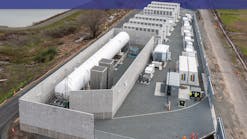Current and Future Opportunities for Energy Storage in New York
2019 has been transformational for the energy storage market in New York, which was marked by several milestones that reveal the powerful forces now emerging and exerting their influence across the state’s electricity landscape.
An ambitious energy storage goal and hundreds of millions of dollars in incentives dedicated to advancing the market has put excitement for energy storage in New York at an all-time high. With new market participation models on the way, it is vital developers understand the greatest opportunities and challenges for the technology, as well as the development of storage in the state, near-term outlooks for utility and distributed storage, and current and potential revenue streams that improve the bankability of a project and justify early entry into New York’s energy storage market.
New York State’s Incentives Accelerate Energy Storage Deployments
Last year, Governor Andrew Cuomo called for an energy storage goal of 1.5 GW by 2025 and the state’s Public Service Commission later established a deployment target of 3 GW by 2030, directing the New York State Energy Research and Development Authority (NYSERDA) and the Department of Public Service (DPS) to recommend next steps.
Recognizing that a sustainable business environment has yet to emerge under current market rules and battery project pricing, the NYSERDA and the DPS designed a Market Acceleration Bridge Incentive Program (MABI) totaling US$280 million to spur the first gigawatt of New York’s 2030 energy storage deployment goal. The theory is that the funding will monetize some of the value of energy storage that companies cannot yet get compensation for. By supporting the early growth of the market, the program hopes to help the industry reach economic sustainability, phasing out incentives as deployments grow.
Since the funds were made available in April, US$92 million of that budget has been committed to 37 projects, representing nearly 150 MW of capacity. With nearly a quarter of the funding accounted for within 6 months, it is clear that storage developers and New York’s energy agencies aren’t waiting for market participation rules to be implemented before deploying projects.
The New York Independent System Operator (NYISO) submitted its most recent filing in response to the Federal Energy Regulatory Commission’s (FERC) Order 841 in May regarding storage in wholesale markets and submitted a separate filing in June regarding the treatment of distributed energy resources (DERs) in its markets. The NYISO is currently waiting for the FERC’s response to both.
New York’s MABI program has thus far proven successful as a temporary fill-in for the dual market participation models that are expected to come online in the early 2020s, with developers and investors deploying projects early as anticipated wholesale market revenues improve the economics of their projects and offer strong first-mover advantages.
The Near-Term Outlook for Utility-Scale Storage
As battery costs and installed costs of utility-scale systems continue to decline, the low-price environment coupled with regulatory measures (like the proposed integration of a carbon price into wholesale electricity markets and proposed air quality regulations in New York City and Long Island), have the potential to accelerate the retirement of coal, nuclear, and aging peaking power plants — making the economic case for storage much stronger in the next several years.
In addition, the pairing of utility-scale storage with renewable generation is also a near-to-mid-term opportunity. While utility-scale renewable projects are less likely to be sited in downstate zones where capacity value is greatest, storage assets charging from a renewable source are still eligible for the Federal Investment Tax Credit, which can lessen the impact of still-high capital costs.
The largest revenue opportunity for energy storage remains within New York City, which has some of the highest electricity capacity prices in the United States and a constraint-ridden transmission network with lucrative locational marginal arbitrage opportunities at several locations. Despite these drivers, projects in New York City must overcome barriers concerning the relative dearth of suitable utility-scale sites and NYISO-imposed buyer-side mitigation measures. Under these rules, new entrants may receive a restrictive capacity market bid floor unless proven to be fully economical under strict standards. Projects relying on contracts with utilities or state subsidies may risk the loss of any capacity market revenues.
Current and Future Opportunities for Distributed Energy Storage
The NYISO’s continued development of its DER and distributed energy storage (DES) participation models could significantly increase the role of DES in the New York market. Several DES value propositions have already been monetized in New York. Opportunities include existing pilot programs like the state’s Value of Distributed Resources (VDER) tariff, customer demand charge reduction, utility programs that compensate for local distribution system services, and on-site backup power valued by commercial and industrial (C&I) or residential customers. Combining these revenues with wholesale market earnings could provide rewarding investment opportunities that drive record level DES deployments as the state strives to meet its energy storage goals.
As it stands, the NYISO has proposed that aggregations of resources — which could include storage, solar, and more — that are at least 100 kW in combined size could participate in energy, capacity, and ancillary services markets depending on their capabilities. The important issue to be clarified is dual participation or value stacking. While the NYISO and the state have both announced plans to clarify dual participation, questions remain regarding how such resources will be operated and remunerated for each unique service provided.
In critical downstate zones, including New York City, where the opportunities are expected to be greatest, the NYISO intends to apply standard buyer-side mitigation measures to DERs. This decision brings uncertainty regarding how alternative and contracted revenues will affect competitive entry tests that could block capacity market sales.
In addition, the city has been working toward finalizing and streamlining its permitting process for distributed lithium-ion batteries sited inside buildings. The stringent, complicated, and one-off nature of the permits needed from the city’s Department of Buildings and the Fire Department of New York has so far limited energy storage projects in the city.
Until the NYISO’s dual market participation model and permitting processes are finalized, use cases involving aggregation of various DER technologies for participation in the NYISO’s wholesale markets exist. These provide the much needed insight into the potential new business models that will benefit all stakeholders, and improve the reliability and resilience of the grid.
Case Study: Enel X and Glenwood Management
Large C&I customers frequently employ DERs to provide multiple benefits, including operational improvements, cost savings, and delivery on corporate sustainability goals, which increasingly include carbon reduction targets.
In New York City, Glenwood Management, one of the state’s largest builders and owners of luxury rental apartments, has worked with Enel X since 2012 to install and operate a range of DER solutions across its portfolio of high-rise urban properties, including both standalone DES and distributed solar plus storage.
DERs are used to protect residents against disturbances in grid energy and to reduce demand charges. In addition to these direct benefits, the assets also participate in retail programs offered by Consolidated Edison (Con Ed) as well as wholesale programs offered by the NYISO. These multiple uses are co-optimized by Enel X through its optimization software platform.
At the retail level, Glenwood’s portfolio of storage assets participates in Con Ed’s retail demand response programs. The assets are aggregated but can be deployed individually according to Con Ed’s location-specific needs. The aggregated DER is optimized to manage locational needs and balance participation in Con Ed’s demand response program against demand charge reduction to lower Glenwood’s electricity costs.
In addition, Glenwood’s portfolio of resources participates in the NYISO’s Special Case Resource (SCR) Program, which is available to end-use loads that can curtail demand and local generators (100 kW or above). Enel X bids these resources into the NYISO Installed Capacity market (ICAP) through the regular auction process.
By participating in both retail and wholesale programs, in addition to meeting on-site needs, Glenwood Management’s DER assets are able to deliver greater overall value, both to Glenwood and to the grid and other customers.
Navigating the Current Landscape
While New York state’s MABI program is helping to develop a sustainable energy storage market, wholesale market revenues will strongly impact the speed and pervasiveness of storage deployment in New York and may tip the balance between competing projects. Although current economics are challenging to forecast, developers and investors should act now to gain a toehold in a market that has the potential to upend the industry structures that have defined electricity markets for the last century.



